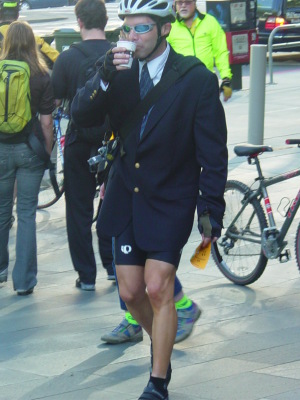 Citing a “build it and they will come” strategy, the Rails-to-Trails Conservancy issued a report promoting more federal funding for bicycle and pedestrian projects.
Citing a “build it and they will come” strategy, the Rails-to-Trails Conservancy issued a report promoting more federal funding for bicycle and pedestrian projects.
The report — “Active Transportation for America: The Case for Increased Federal Investment in Bicycling and Walking” — makes the case that spending more on bicycling and pedestrian facilities would provide benefits to Americans far beyond the amount that was invested.
The Conservancy is seeking $2 billion in alternative transportation funding for 40 communities.
Encouraging people out of their cars would reduce the need to spend billions on highway improvements to deal with traffic congestion. It will also cut oil dependency as well as curtail greenhouse gas emissions and reduce the nationwide obesity problem.
Trips by car
Of course, we already know this. That's why many bicyclists ride their bikes to work, or the nearest mass transit stop, and use their wheels to run errands around the neighborhood.
What's surprising is how many people don't.
Two-thirds of 1-mile or less trips are made by car. Half the trips we make are within a 20-minute bike ride and a quarter are within a 20-minute walk. Even so, most of those trips are by car.
Trips by bike
Transportation spending policies for bicycling show how more people can be coaxed out of their cars.
In 1990 Portland, Oregon, for instance, only 1.2% of commuters used their bicycles. After spending an average $3.50 per resident for bicycling-related improvements, that rate has risen to 6% overall, and 12% in the downtown, by 2007.
The report cites projects in other cities, such as Minneapolis, Camden (NJ), Seattle and elsewhere that are being made on behalf of bicyclists and pedestrians.
Infrastructure
The report calls for more spending on bike lanes, wider lanes, shared roadways, paved shoulders, bike paths, sharrows, bike boxes, bike crossing signals, bike route signs, bike parking, bike stations.
With one mile of urban four-lane costing $20 million to $80 million, hundreds of miles of bike and pedestrian paths can be built.
Even modest increases is bicycling and walking could cut oil dependence and greenhouse gas emissions by 3%; substantial increases could cut those dependencies by 8%. The benefits also include reduced spending on health care by cutting back illnesses associated with obesity.
The Billings Gazette reports that the Rails-to-Trails Conservancy is seeking an expansion of the Nonmotorized Transportation Pilot Project in 2005 that gave $25 million to each of four communities for bicycle and pedestrian projects. The current proposal would seek $50 million each for 40 communities.
See the 2010 Campaign for Active Transportation at the Rails-to-Trails Conservancy website.
The report was written with support from Bikes Belong. It was presented to US Rep. James Oberstar, the Minnesota Democrat who chairs the House Committee on Transportation and Infrastructure.

Recent Comments